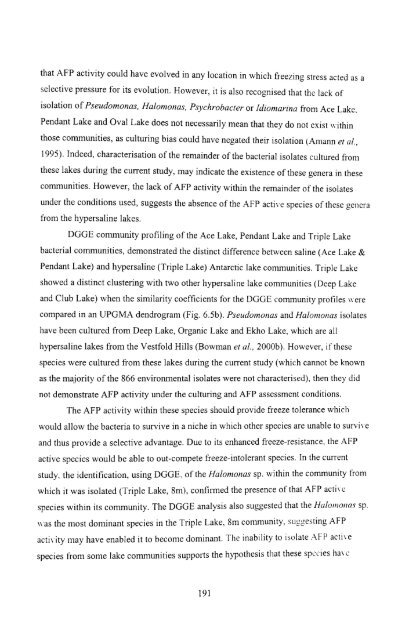ý.,,: V. ý ýý . - Nottingham eTheses - University of Nottingham
ý.,,: V. ý ýý . - Nottingham eTheses - University of Nottingham
ý.,,: V. ý ýý . - Nottingham eTheses - University of Nottingham
You also want an ePaper? Increase the reach of your titles
YUMPU automatically turns print PDFs into web optimized ePapers that Google loves.
that AFP activity could have evolved in any location in which freezing stress acted as a<br />
selective pressure for its evolution. However, it is also recognised that the lack <strong>of</strong><br />
isolation <strong>of</strong> Pseudomonas, Halomonas, Psychrobacter or Idiomarina from Ace Lake,<br />
Pendant Lake and Oval Lake does not necessarily mean that they do not exist within<br />
those communities, as culturing bias could have negated their isolation (Amann et al.,<br />
1995). Indeed, characterisation <strong>of</strong> the remainder <strong>of</strong> the bacterial isolates cultured from<br />
these lakes during the current study, may indicate the existence <strong>of</strong> these genera in these<br />
communities. However, the lack <strong>of</strong> AFP activity within the remainder <strong>of</strong> the isolates<br />
under the conditions used, suggests the absence <strong>of</strong> the AFP active species <strong>of</strong> these genera<br />
from the hypersaline lakes.<br />
DGGE community pr<strong>of</strong>iling <strong>of</strong> the Ace Lake, Pendant Lake and Triple Lake<br />
bacterial communities, demonstrated the distinct difference between saline (Ace Lake &<br />
Pendant Lake) and hypersaline (Triple Lake) Antarctic lake communities. Triple Lake<br />
showed a distinct clustering with two other hypersaline lake communities (Deep Lake<br />
and Club Lake) when the similarity coefficients for the DGGE community pr<strong>of</strong>iles were<br />
compared in an UPGMA dendrogram (Fig. 6.5b). Pseudomonas and Halomonas isolates<br />
have been cultured from Deep Lake, Organic Lake and Ekho Lake, which are all<br />
hypersaline lakes from the Vestfold Hills (Bowman et al., 2000b). However, if these<br />
species were cultured from these lakes during the current study (which cannot<br />
be known<br />
as the majority <strong>of</strong> the 866 environmental isolates were not characterised), then they did<br />
not demonstrate AFP activity under the culturing and AFP assessment conditions.<br />
The AFP activity within these species should provide freeze tolerance which<br />
would allow the bacteria to survive in a niche in which other species are unable to survive<br />
and thus provide a selective advantage. Due to its enhanced freeze-resistance, the AFP<br />
active species would be able to out-compete freeze-intolerant species. In the current<br />
study, the identification, using DGGE, <strong>of</strong> the Halomonas sp. within the community from<br />
which it was isolated (Triple Lake, 8m), confirmed the presence <strong>of</strong> that AFP active<br />
species within its community. The DGGE analysis also suggested that the Halonnonas sp.<br />
was the most dominant species in the Triple Lake, 8m community, suggesting AFP<br />
activity may have enabled it to become dominant. The inability to isolate AFP active<br />
species from some lake communities supports the hypothesis that these species have<br />
191
















